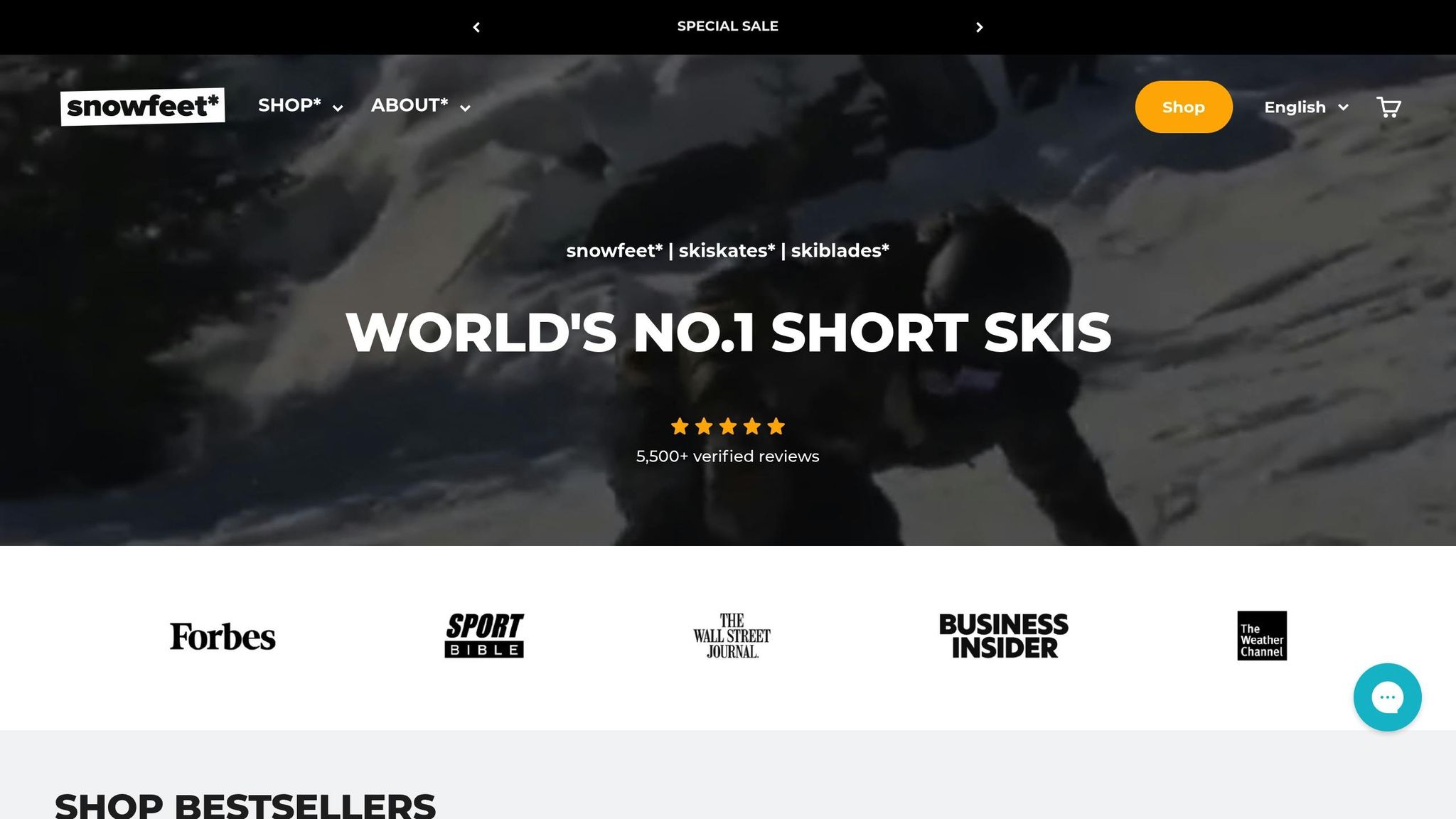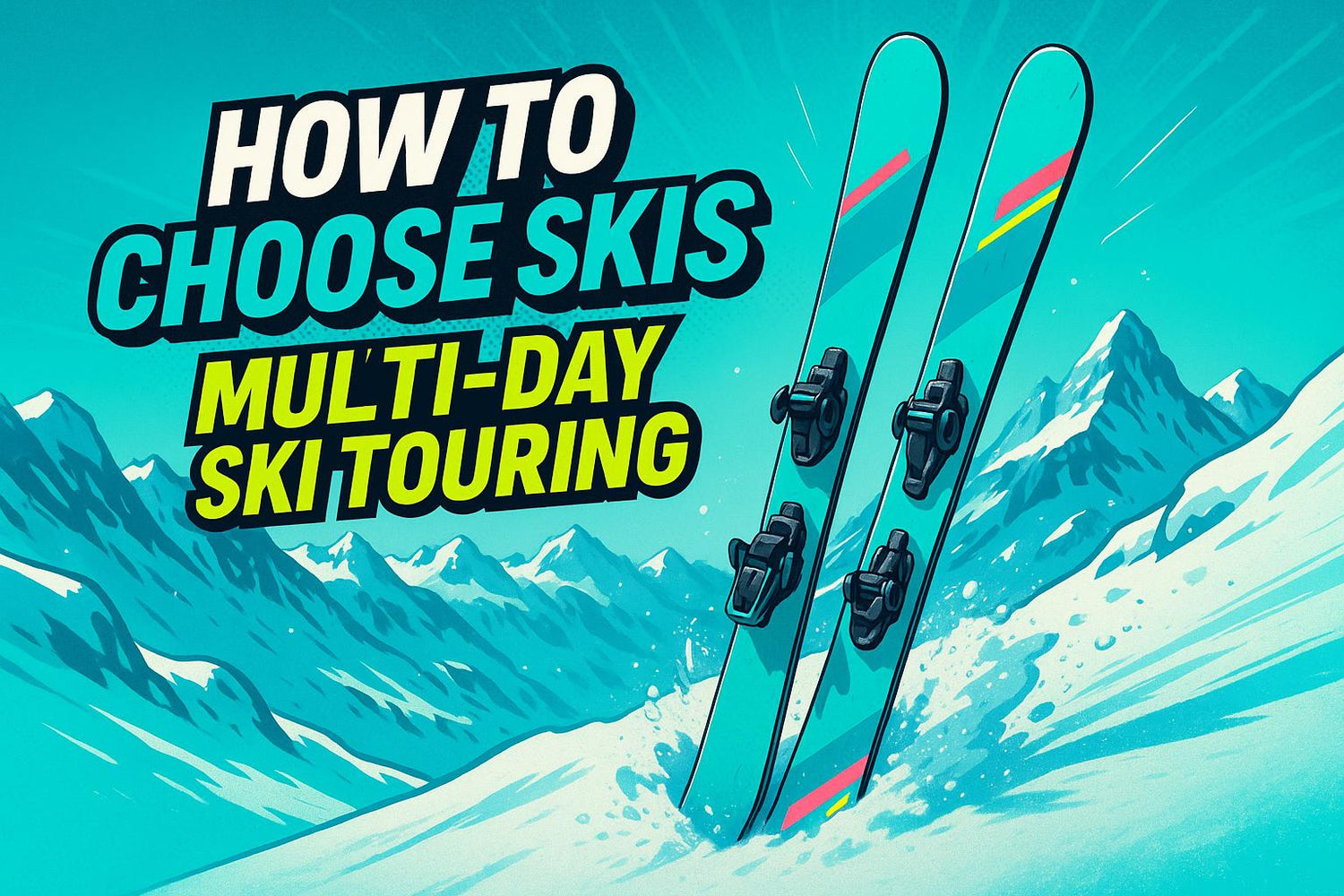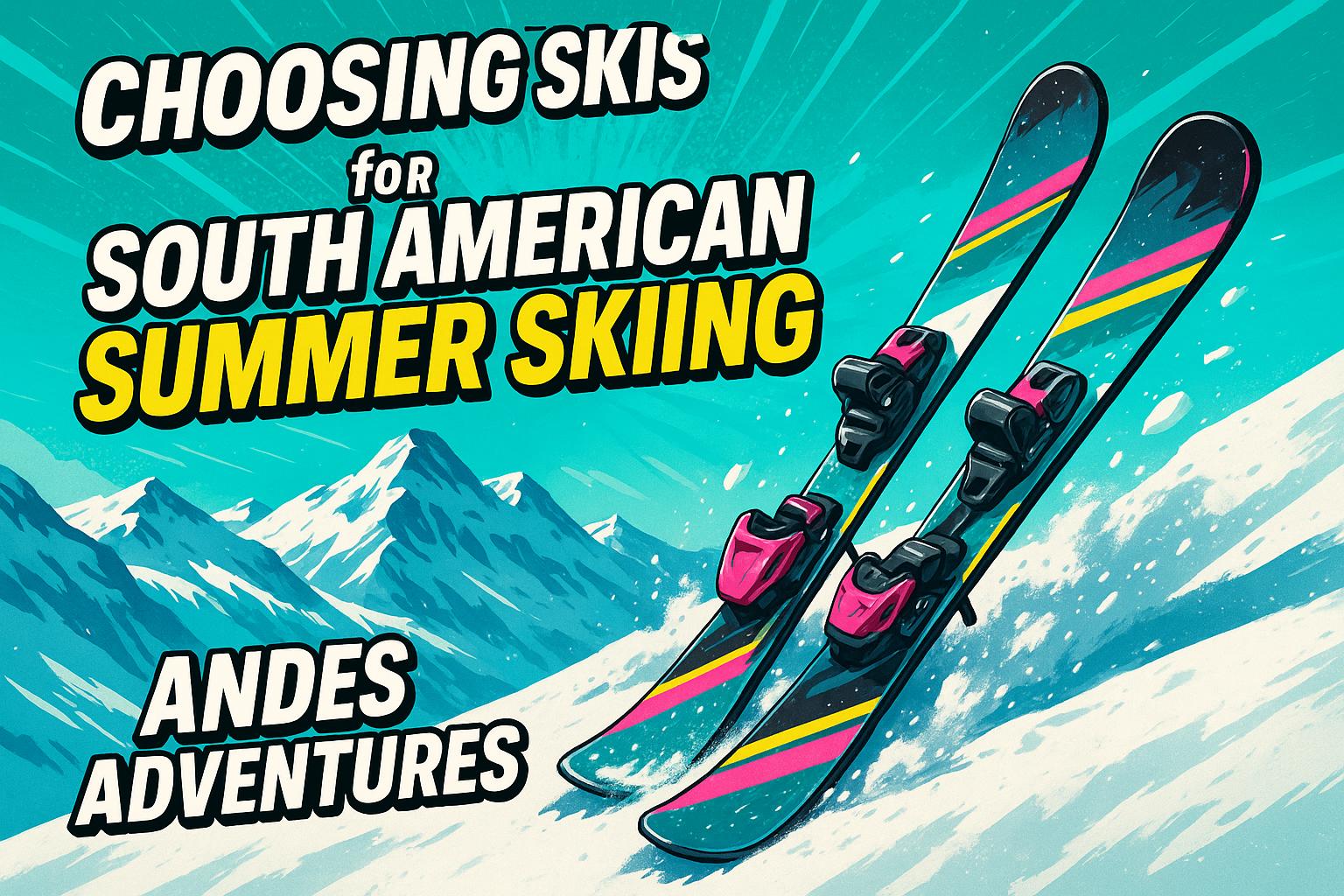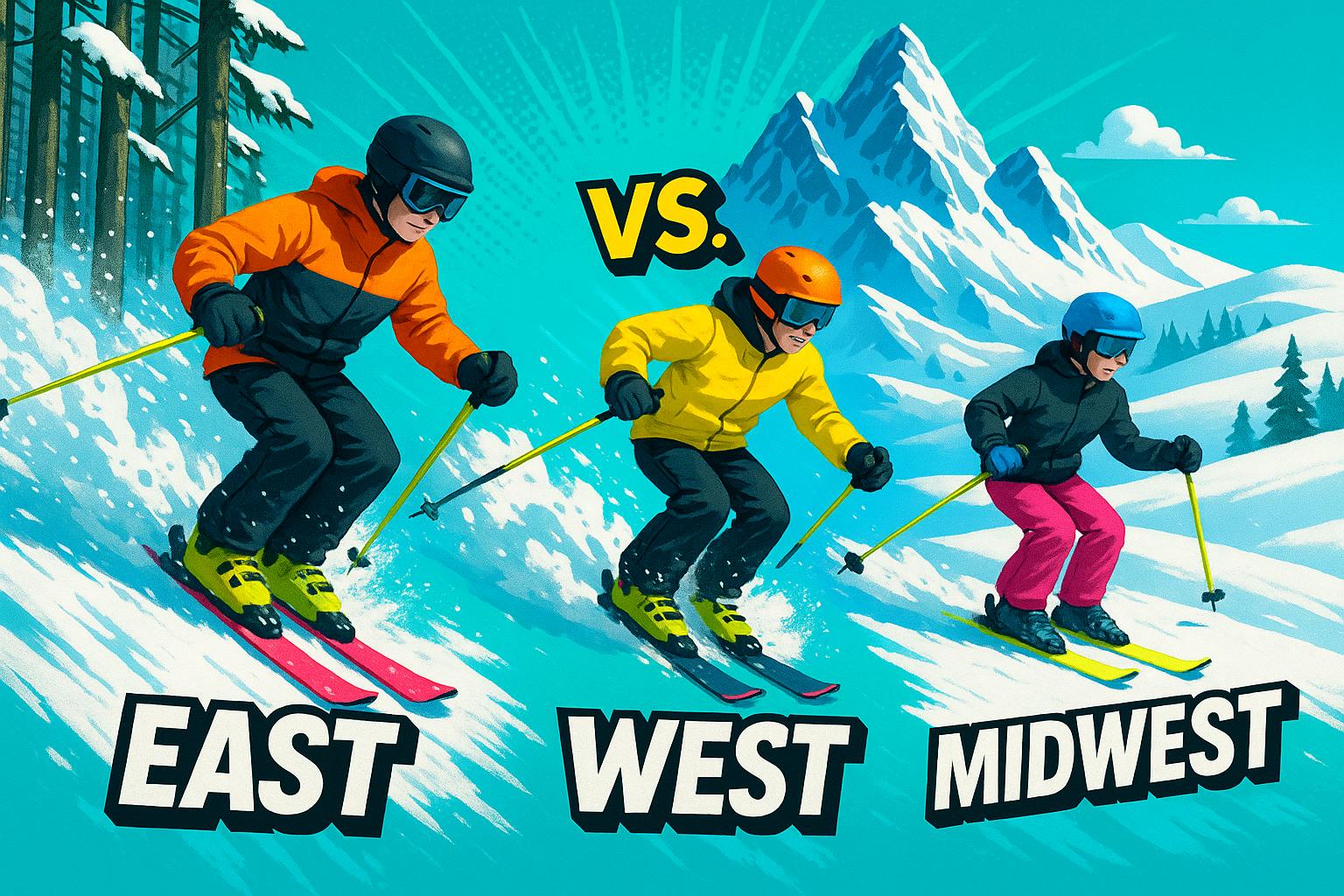Looking for the perfect skis for multi-day ski tours or hut trips? Here's what you need to know:
- Weight Matters: Lightweight skis (under 6 lbs per pair) reduce fatigue during long uphill climbs.
- Compact Design: Short skis (65–120 cm) are easier to pack and handle in tight or technical terrain.
- Durability is Key: Backcountry conditions demand skis that can handle rough snow, rocks, and trees.
- Boot Compatibility: Snowfeet skis work with regular winter or snowboard boots, saving money on specialized gear.
- Cost Comparison: Snowfeet setups cost around $499, while traditional setups can exceed $2,200.
Quick Comparison
| Feature | Snowfeet Skiblades (65–120 cm) | Snowfeet WALKSKI (100 cm) | Standard Touring Skis (160–180 cm) |
|---|---|---|---|
| Weight | Under 6 lbs | Under 5 lbs | 8–12 lbs |
| Boot Compatibility | Winter/snowboard boots | Winter/snowboard boots | Specialized AT boots |
| Price | $450–$690 | $499 | $2,200+ |
| Portability | Fits in backpack | Ultra-compact | Requires external carrying system |
| Best Terrain | Tight spaces, mixed snow | Backcountry tours | Deep powder, high-speed descents |
Snowfeet short skis are a lightweight, cost-effective option for most multi-day tours, especially in moderate terrain and mixed snow conditions. Dive into the article to learn more about choosing the right skis for your next adventure!
The Best Ski Touring Equipment for 2025
What Multi-Day Ski Touring and Hut Trips Require
Multi-day ski touring puts your gear to the ultimate test. These trips demand equipment that's lightweight, efficient, and tough enough to handle long days in unpredictable conditions.
Picture this: on a six-day hut trip, you'll likely spend up to 90% of your time climbing uphill, tackling anywhere from 3,500 to over 5,000 vertical feet each day. That’s a lot of effort, made even harder by changing weather and snow conditions. One moment, you’re breaking through fresh powder; the next, you’re navigating icy crust or wind-packed snow. Your skis need to keep up without adding unnecessary weight or bulk to your pack. Traditional longer skis can be a hassle in these scenarios, creating more wind resistance and making transitions clunkier. That’s where Snowfeet* skis shine - compact, lightweight, and designed to handle a variety of snow conditions while staying out of your way.
Why Lightweight and Reliable Skis Matter
When you’re hauling multiple days’ worth of food, safety gear, and shelter, every ounce matters. A heavier setup can wear you down quickly, especially on those endless uphill climbs. Lightweight skis help conserve your energy, letting you focus on the journey instead of your burning legs. And when your pack already weighs 35–40 pounds, saving even 2–3 pounds on skis can make a huge difference.
Durability is just as important. Out in the backcountry, miles from the nearest help, a broken binding or damaged ski edge isn’t just inconvenient - it’s dangerous. Snowfeet* skis are built for reliability, with shorter lengths and sturdy construction that can handle rough terrain, rocks, and trees. Their compact size also means you can stash them inside your pack, avoiding the hassle of external ski carrying systems. This not only protects your skis but also keeps your setup streamlined.
Hut-to-Hut Skiing Popularity in the US
Hut-to-hut skiing is booming in the US, and for good reason. It’s the perfect mix of adventure and comfort, with skiers tackling remote trails by day and enjoying cozy huts by night. But unlike Europe, where huts are often close together, American hut systems usually involve long approaches - think 8–12 miles with significant elevation gain. This makes lightweight, packable gear even more essential.
Snowfeet* skis are tailor-made for these challenges. With sizes ranging from 65 cm to 120 cm, they offer the maneuverability you need for tight forest trails and technical terrain. Their shorter length makes them easier to handle in tricky spots, while still providing enough surface area to handle different snow conditions. Plus, their compact design means you can pack them inside your backpack - no need for roof racks or awkward external straps. Just toss them in your bag, load up the car, and hit the trailhead.
What to Look for When Choosing Touring Skis
Picking the right touring skis for multi-day adventures is all about finding gear that works with you, not against you. Since about 90% of backcountry touring involves uphill travel, factors like weight, maneuverability, and durability can make or break your trip.
Weight and Portability
When you're climbing 3,000 to 4,000 feet in a single day, every ounce matters. Most traditional touring skis weigh between 1,200 and 1,600 grams per ski, and some models can be even heavier. Snowfeet* skis are designed to be much lighter, which is a game changer for those six- to eight-hour hut-to-hut trips. Their lightweight design not only makes them easier to carry but also improves maneuverability on tricky sections. Plus, their compact size means you won’t need bulky external ski-carrying systems that can snag on branches or create extra drag. Lighter skis make everything feel smoother, especially in tight or technical terrain.
Ski Length and Maneuverability
Ski length is a big deal when you're weaving through dense trees or tackling steep, narrow sections. Traditional touring skis, like those from brands such as Head, Elan, and Rossignol, typically range between 160 cm and 180 cm. While these offer good floatation, they can feel clunky when you need quick turns. Snowfeet* takes a different approach with their compact designs. For example, their 65 cm Skiblades are super agile in confined spaces, while the 120 cm option strikes a balance between surface area and portability. Shorter skis also reduce the leverage effect during impacts, which means less risk of twisting injuries - something you definitely want to avoid when you're far from help.
Binding and Boot Compatibility
Another key factor is how well your skis work with the gear you already own. Traditional touring setups often require specialized alpine touring (AT) boots and bindings. Tech bindings typically weigh 1 to 3 pounds per pair, while frame bindings can go up to 7 pounds. Snowfeet* simplifies things by being compatible with your existing winter or snowboard boots. This eliminates the need for extra gear and reduces potential failure points - an important consideration when you're deep in the backcountry.
Durability and Construction
Lightweight touring skis (under 1,200 grams per ski) are great for uphill efficiency, but they often come with a trade-off: they can be fragile. On multi-day trips, durability is non-negotiable. A broken ski or damaged edge can cut your adventure short in the worst way. Snowfeet* addresses this by using smart design principles. Their shorter skis distribute impact forces more evenly, reducing stress during rough landings. With sturdy edges and tough bases, Snowfeet* skis can handle everything from soft powder to icy hardpack. This balance between lightness and toughness makes them a solid choice for extended backcountry journeys.
Snowfeet* Short Skis vs. Standard Touring Skis

Deciding between Snowfeet* short skis and traditional touring skis (like Rossignol, Atomic, or Elan) can completely change your multi-day skiing experience. Let’s break down the specs and real-world performance to help you choose.
Comparison Table: Snowfeet* vs. Standard Touring Skis
| Feature | Snowfeet* Skiblades (65–120 cm) | Snowfeet* WALKSKI (100 cm) | Standard Touring Skis (Rossignol, Atomic, Elan) |
|---|---|---|---|
| Length | 65–120 cm | 100 cm | 160–180 cm |
| Weight per pair | Under 6 lbs | Under 5 lbs | 8–12 lbs (skis + bindings) |
| Boot compatibility | Winter shoes, snowboard boots | Winter shoes, snowboard boots | Specialized alpine touring boots |
| Total setup cost | $450–$690 | $499 | $2,200+ (skis, bindings, boots) |
| Portability | Fits in a backpack | Ultra-compact | Requires an external carrying system |
| Best terrain | Varied conditions, tight spaces | Backcountry touring | Deep powder, high-speed descents |
| Learning curve | Beginner-friendly | Easy to master | Requires experience |
Why Choose Snowfeet* Short Skis?
Snowfeet* short skis bring some serious perks to multi-day hut trips. Their compact size and lightweight design (under 6 lbs per pair) make them a dream for navigating tight spaces like moguls or terrain parks. Plus, they’re easy to carry and won’t weigh you down during extended uphill climbs.
Another bonus? You don’t need specialized alpine touring boots. Snowfeet* short skis work with regular winter shoes or snowboard boots, saving you from splurging on extra gear. Speaking of savings, the price tag is a big win - around $499 for the Snowfeet* WALKSKI compared to the $2,200+ investment required for a traditional touring setup. That’s money you can put toward lodging, meals, or even more gear.
While Snowfeet* skis shine in most touring scenarios, there are times when traditional skis might be the better pick.
When Traditional Skis Have the Edge
Traditional touring skis, like those from Rossignol, Atomic, or Elan, excel in specific conditions. In deep powder, their longer length and larger surface area provide better floatation. They’re also more stable at high speeds and offer better grip on hard-packed snow. For expert skiers chasing downhill thrills or those tackling Olympic-level descents, the performance of traditional setups is hard to beat.
That said, for the majority of multi-day tours involving moderate terrain, mixed snow conditions, and long uphill stretches, Snowfeet* short skis are a lightweight, maneuverable alternative that fits the bill perfectly for extended backcountry adventures.
sbb-itb-17ade95
Best Snowfeet* Models for Multi-Day Ski Touring
Looking to elevate your ski touring game with lightweight, durable gear? Here’s a breakdown of the best Snowfeet* models designed for multi-day adventures.
Snowfeet* Skiblades (65 cm, 99 cm, 120 cm)
Snowfeet* Skiblades come in three sizes - 65 cm, 99 cm, and 120 cm - each tailored to different touring preferences.
- 65 cm Skiblades: Priced from $450, these are perfect for beginners or freestyle enthusiasts. Their compact size makes them easy to control on tight trails and in mixed snow conditions. Plus, they’re a breeze to pack, making them a great choice for extended trips.
- 99 cm Skiblades: Starting at $490, this model strikes a balance between agility and stability. They’re versatile enough to handle the variety of conditions you’ll encounter on a multi-day tour, offering quick turns and steady descents.
- 120 cm Skiblades: At $690, these are ideal for skiers who want more stability for aggressive descents. Despite their longer length, they remain portable and lightweight - hallmarks of Snowfeet* gear.
All Skiblades are designed with portability in mind, making them easier to carry compared to traditional touring setups. If you’re venturing into more challenging backcountry terrain, though, you might want to check out the Snowfeet* WALKSKI.
Snowfeet* WALKSKI Backcountry Touring Skis (100 cm)
For those who need versatility and performance in the backcountry, the WALKSKI is a standout option. At 100 cm in length and priced at $490, these skis are lightweight yet capable of handling varied terrain. When compared to traditional touring setups - which can cost around $2,200 for skis, bindings, and boots - the WALKSKI offers a budget-friendly alternative without compromising functionality.
Key features include:
- Universal free-heel bindings: Compatible with winter shoes, ski boots, and even snowboard boots.
- Removable climbing skins: These provide excellent grip for uphill sections, making steep ascents to mountain huts far more manageable.
The compact design of the WALKSKI makes it easy to navigate powder, packed trails, or groomed slopes. Whether you’re heading hut-to-hut or tackling mixed conditions, these skis are built to perform.
Easy Transport for Long Tours
Both the Skiblades and WALKSKI models are designed to simplify transport. You can pack them into a backpack or secure them to the outside without the hassle of bulky carrying systems. This streamlined approach is a game-changer for long approaches or technical terrain, where every ounce matters.
Tips for Comfortable and Efficient Ski Touring
Multi-day ski touring isn’t just about having the right skis - it’s also about planning ahead and using smart strategies to stay comfortable and efficient on the trail.
Layering and Managing Temperature Changes
When you’re out on a multi-day ski tour, you’ll face all kinds of temperature swings. From climbing steep slopes to descending into chilly valleys, the weather and your activity level can change fast. The trick? A layering system that can keep up with you.
"Dressing for ski touring is best approached with the same mind-set as mountaineering, where lightweight, comfortable, and adaptable layering systems trump the very protective but heavy and cumbersome clothing usually used for piste skiing." - Mountain Equipment
Start with a base layer that wicks away sweat - skip the cotton, trust me. Then, add a mid-layer like fleece or synthetic insulation to trap heat. Top it off with a waterproof and windproof outer layer that has ventilation zippers. Those zippers are lifesavers when you need to cool down without peeling off layers.
Here’s a pro tip: begin your tour feeling a little chilly. You’ll warm up as you start moving, and this prevents overheating and sweating too much. If you’re someone who sweats a lot, pack an extra base layer to swap out during breaks. And don’t forget your extremities - neck gaiters, gloves, or mittens can make a huge difference. Gloves give you better grip for handling gear, while mittens are all about staying warm.
Once your layering game is on point, it’s time to think about keeping your gear organized and ready for action.
Carrying and Maintaining Gear
When you’re carrying everything you need for days on end, efficient gear management is key. Luckily, the compact design of Snowfeet* skis makes this a little easier compared to traditional setups.
Pack your Snowfeet* skis in a compact bag that can hold other essentials too. A ski boot backpack with compartments for boots, a helmet, goggles, and smaller items will keep you organized.
Bring a small maintenance kit with essentials like a multi-tool, bungee cords, and tape for quick fixes. After skiing, dry your skis and edges to avoid rust. Take out your boot liners to dry them (but keep them away from direct heat to prevent damage) and buckle the boots back up once they’re dry to maintain their shape.
Store all your gear in dry containers or backpacks to shield it from moisture and UV rays. Keep an emergency kit in your car with extras like socks, hats, and mittens for unexpected situations. If you’re worried about forgetting something, make a laminated checklist of must-have items - it’s a small step that saves big headaches.
With your gear sorted, the next step is testing everything before you hit the trail.
Testing Gear Before Long Trips
Imagine this: you’re miles into the wilderness, and your gear starts failing. Not fun, right? That’s why pre-trip testing is so important, especially when you’re relying on the compact and versatile Snowfeet* equipment.
"Prior preparation prevents a piss-poor powder pageant!" - Joe Howdyshell, Head Coach at Summit Endurance Academy
Start with the basics. Check for loose or missing screws in your boots and bindings, and use threadlocker if needed. Lay out all your clothing layers to make sure nothing’s missing, and inspect your boot liners for wear. If they’re looking rough, consider heat molding or replacing them.
For WALKSKI’s climbing skins, check the glue. If it’s losing its stickiness, re-glue or replace them. Practice putting the skins on and taking them off at home to get the hang of it before you’re out in the cold.
Don’t skip over safety gear. Replace transceiver batteries, check for corrosion, and update any software if needed. Assemble your probe and shovel to ensure they’re in good shape, and test your beacon. While you’re at it, practice rescue techniques with your ski buddies - it’s better to be over-prepared than caught off guard.
Finally, give your Snowfeet* skis some TLC. Repair any damage, clean them, and apply wax. Leave the wax on if you’re storing them - it helps protect the base. Oh, and swap out any old snacks in your pack. No one wants to find a crushed granola bar from last season when hunger strikes.
Why Snowfeet* is the Best Choice for Multi-Day Ski Touring
Snowfeet* short skis pack an unbeatable combination of portability, versatility, and affordability for multi-day touring adventures. While a traditional backcountry ski setup can set you back around $2,200, the Snowfeet* WALKSKI comes in at just $499. And it’s not just about saving money - these skis are engineered to perform, making them a smart choice for serious outdoor enthusiasts.
At a compact 100 cm in length, the WALKSKI is designed to strap right onto your backpack, making it easy to hike to remote spots without feeling like you’re hauling a ton of gear. Compare that to typical backcountry skis from brands like Rossignol or Atomic, which are usually 170–180 cm long and require awkward, bulky carrying systems on steep or technical terrain.
The shorter length also means quicker, more responsive turns and easier handling overall. This agility not only makes navigating tight trails and unpredictable snow conditions a breeze but also helps reduce fatigue on long trips. Experienced users consistently highlight this advantage:
"With these little skis, you feel much more agile, faster, and above all – comfortable. No buckles, no heavy boots – just strap in and go." – Jakub F
Another standout feature is the universal compatibility of the WALKSKI bindings. Unlike traditional setups that demand specialized boots, these bindings work with winter boots, ski boots, and even snowboard boots. This flexibility is something you just won’t find with brands like Head or Elan. Whether you're cruising through powder, packed trails, or groomed slopes, these skis adapt seamlessly to the terrain.
The performance speaks for itself. Snowfeet* Store reviews show an impressive average rating of 4.90 out of 5 from 5,589 reviews. For multi-day ski tours or hut trips - where every ounce of weight matters - Snowfeet* hits the sweet spot with its lightweight design, terrain versatility, and durability. And when you’re far from civilization, having gear you can rely on is priceless.
FAQs
How do Snowfeet short skis stack up against traditional touring skis for multi-day trips?
Snowfeet short skis, like the Skiblades (65 cm to 120 cm) and WALKSKI Backcountry Touring Skis (100 cm), are a fantastic option for multi-day ski tours. Their lightweight and compact design makes them much easier to carry and handle, cutting down on fatigue during those long treks. Unlike traditional touring skis, which can feel cumbersome and demand more effort, Snowfeet skis are great for navigating tight trails and tackling mixed terrain without breaking a sweat.
While traditional skis have the edge when it comes to speed and stability on steep slopes, Snowfeet skis bring something different to the table: versatility. They perform well on groomed trails, light powder, and even in mixed conditions, making them a solid pick for recreational skiers who value agility and having a good time. If you're planning a multi-day trip and need something portable, easy to use, and reliable, Snowfeet short skis are a top-notch choice.
Why should I use Snowfeet skis with regular winter or snowboard boots instead of alpine touring boots?
Using Snowfeet skis with regular winter or snowboard boots comes with some pretty awesome perks, making them a smart and flexible option for ski touring or hut trips. Let’s break it down:
First up, compatibility. Snowfeet skis work perfectly with your standard winter or snowboard boots. That means you don’t have to splurge on pricey alpine touring boots, which is a win for your wallet. Plus, it opens the door for more people to give them a try - no fancy gear required.
Next, there’s comfort. Regular winter boots are way more flexible and comfy compared to stiff alpine touring boots. If you’re heading out on long treks or just want something easier on your feet, this is a big deal. Walking around in them feels natural, even after hours.
And don’t forget, these skis are lightweight and portable. They’re small enough to stash in a backpack, making them ideal for multi-day trips or quick outings. Whether you’re a beginner or a seasoned skier looking for something easy to use, Snowfeet skis are a hassle-free, fun alternative to traditional ski gear.
Are Snowfeet skis good for all terrains and snow conditions on multi-day hut trips?
Snowfeet skis are built to tackle all kinds of terrain and snow conditions, making them an excellent companion for multi-day hut trips. Whether you're carving through fresh powder, handling icy stretches, or cruising along groomed trails, these skis offer dependable performance. Thanks to their shorter length and lightweight build, they’re super portable and easy to control, which means less fatigue on those long adventures.
Unlike traditional skis, which can be bulky and often designed for specific conditions, Snowfeet skis bring a level of flexibility that's hard to beat. Take the Snowfeet Skiblades, for example - they’re perfect for light powder and groomed runs. For deeper snow, wider models provide better float. This versatility makes Snowfeet skis a solid option for skiers of all levels who want something that’s comfortable, convenient, and ready for a mix of backcountry challenges.


































Leave a comment
This site is protected by hCaptcha and the hCaptcha Privacy Policy and Terms of Service apply.